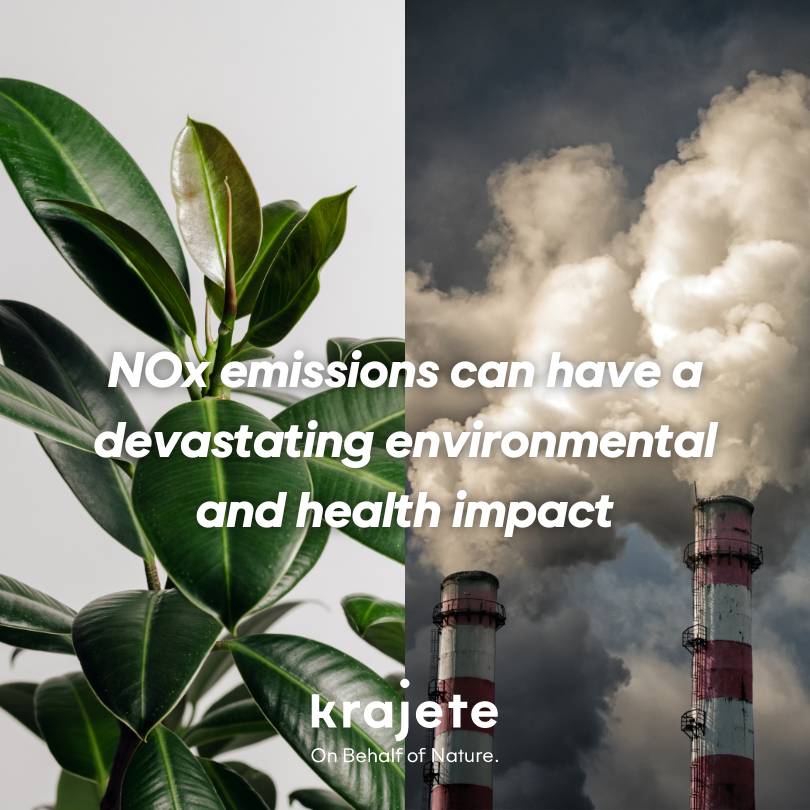EU and U.S. regulations now clamp stack NOx at 50 mg/Nm³. This guide ranks every major NOx control method—from low-NOx burners and SCR/SNCR to advanced data-driven tuning and regenerative dry-bed adsorption—so you can close permit gaps, meet the strictest regulatory limits, and trim compliance OPEX by up to 20 %.
Nitrogen oxides—NO and NO₂—form whenever fuel hits flame temperature. These emissions drive smog, acid rain, and ground-level ozone, costing Europe €260 billion a year, according to the European Environment Agency (EEA). The urgency of reducing these emissions is paramount, as regulators have reacted with stack caps as low as 50 mg/Nm³.
Industrial emitters, such as power plants, refineries, steel mills, cement kilns, marine engines, and mining fleets, must now meet the EU Industrial Emissions Directive, U.S. EPA MACT+NSPS, and IMO Tier III standards. Missing these marks invites fines, permit delays, and forced curtailments that erode EBITDA.
Fortunately, operators can pull three aligned levers to reduce NOx emissions, hit tightening permit limits, and protect cash flow, ESG metrics, and asset reliability—covering the full spectrum of NOx-control methods:
This guide covers both traditional and emerging NOx control technologies. Performance ranges, cost tables, regulatory checkpoints, and case studies show where each method fits—helping you stay compliant while managing total emissions and cost.
Lower Your NOx—And Your CAPEX
One Krajete retrofit saved €100k–250k in capex vs SCR. All while hitting EU and EPA limits.
Industrial boilers, turbines, and kilns convert nitrogen in the air into harmful NOx emissions. These gases worsen smog and respiratory illness—and, according to CE Delft, cost society about €22 per kilogram released.
Unsurprisingly, regulators in the EU, the U.S., and the International Maritime Organization keep tightening NOx limits. Staying within those limits protects permits and public health and can generate revenue if captured NOx is later converted into saleable nitric acid.
Uncontrolled NOx is a financial liability: excess emissions can trigger five- and six-figure penalties or allowance purchases. Dutch regulators, for example, list administrative fines of up to €450 000 for emissions-reporting failures under the EU ETS. In some EU regions, plants may even be ordered offline until abatement is installed—an outage that dwarfs the cost of most control systems.
Large gas turbines and coal boilers were early targets, but rules now reach diesel mine trucks, refinery heaters, and deep-sea engines. IMO Tier III standards require new marine engines in Emission Control Areas to cut NOx by roughly 75–80 % versus Tier I levels, and retrofit pathways are under review. Similar pressure lands on cement and steel kilns already juggling CO₂ targets.
In later sections, we compare each NOx-control method in depth—cost, payback, and the regulations it satisfies.
Turn NOx from Penalty to Product
Capture NOx and valorise it as nitric acid. Support ESG goals while offsetting O&M costs.
Cutting NOx at the flame front is usually cheaper than scrubbing it later. Primary measures modify how fuel and air meet, lowering peak temperatures and oxygen levels.
Below are three widely adopted NOx control methods—low-NOx burners, flue-gas recirculation, and staged (over-fire) air—that can deliver meaningful reductions while keeping plant layouts largely intact.
An LNB modifies the burner throat and stages the fuel–air mix. The first zone runs fuel-rich and cooler; a second zone completes burnout, so less “thermal” NOx forms.
The U.S. Environmental Protection Agency (EPA)—the federal body that writes and enforces air-quality rules—notes in its AP-42 handbook that installing a low-NOx burner on gas- or oil-fired boilers can cut NOx by about 40–60 %, and even more when the burner works alongside flue-gas recirculation.
Flue-gas recirculation takes part of the exhaust leaving the stack and mixes it back in with the fresh air going to the burner. The recycled gas dilutes the oxygen and cools the flame, so less NOx can form.
When FGR is added to a low-NOx burner, plants often see total cuts of ≈ 60 % on natural-gas units, according to the U.S. EPA AP-42 data.
OFA splits the combustion air into two stages. Roughly 75–85 % enters through the burners, while the remaining 15–25 % “over-fires” through nozzles higher up the furnace. The lower flame runs fuel-rich and cooler, creating less thermal NOx; the upper nozzles add the last air so the fuel finishes burning before the gas hits the boiler tubes.
U.S. Department of Energy retrofit studies on coal- and biomass-fired boilers report 30–60 % lower NOx when OFA is tuned correctly. Results often improve further when OFA is paired with a low-NOx burner.
Cut NOx Below 0.001 ppm
Schedule a 30-minute chat to learn how Krajete’s regenerative adsorber meets EU IED limits without ammonia or catalyst change-outs.
En savoir plusIf primary measures fall short, plants turn to post-combustion systems. These options carry higher CAPEX but deliver deeper NOx cuts. Both SCR and SNCR react NOx with ammonia; they differ in catalyst use, operating temperature, and total ownership cost. Understanding those trade-offs helps you match technology to permit needs and operating realities.
SCR—one of the best-known NOx-reduction methods—injects a fine mist of ammonia (or urea) into the flue gas, then passes the mixture through a vanadium–titanium catalyst. On the catalyst surface, NOx reacts with the reagent and exits the stack as nitrogen and water. Field data from EPA AP-42 (2024) show removal efficiencies of 90–95 % when the gas temperature is maintained between 250 °C and 450 °C.
Advantages
Drawbacks
Plants short on space or wary of ammonia often look at alternative or hybrid solutions.
SNCR also addresses NOx after combustion, but it skips the catalyst. Operators spray ammonia or urea directly into a hot gas zone—roughly 850–1,100 °C—where the reagent reacts with NOx on its own, yielding nitrogen and water. EPA cost manuals and DOE field trials report 30–70 % NOx removal when injection temperature and mixing are optimised.
Advantages
Drawbacks
Industrial plants that need to meet strict NOx limits, cut operating spend, and harvest by-product value now have a viable alternative to SCR and SNCR: Krajete’s Regenerative NOx Removal and Valorisation system
The single-step adsorber captures NOx at ambient temperature, holds stack levels below 1 ppm, and runs without ammonia—no catalyst swaps, slip monitoring, or Seveso paperwork. Flue gas passes through zeolite drums whose micropores trap NOx
Field trials on cold-start engines and dilute flue streams show > 90 % overall NOx removal with sub-ppm outlets—all without catalyst fouling.
Advantages
Drawbacks
Low-Temperature Stack? No Problem
Discover ambient-temperature NOx removal that slots into tight ducts and eliminates costly gas reheating.
Learn moreTo determine the right NOx strategy, begin by logging your current stack levels. Note the operating-temperature window of each boiler or engine. If you are already close to the limit, in-flame tweaks may suffice; a wider gap usually calls for a choice between an ammonia-based system and Krajete’s regenerative adsorber.
Over its lifetime, SCR or SNCR entails regular reagent deliveries, catalyst swaps every three to five years, and the paperwork tied to hazardous-storage permits.
By contrast, Krajete’s dry skid keeps outlet NOx below 1 ppm with no ammonia, reheating, or Seveso reporting.
In a 2024 pipeline retrofit near Valencia, capital expenditure fell by up to €250 000 and annual operating costs dropped about €50 000 versus SCR, while onsite nitric-acid sales added new revenue—delivering payback in under three years.
As looming multi-gas rules and ESG disclosure requirements take hold, valorising captured NOx positions your plant not only for today’s permit but for the stricter standards that follow, making an early feasibility review with Krajete a low-risk, high-return next step.
NOx Control for Today’s Challenges
Whether you need lower OPEX, no reagent, or circular upside—there’s a smarter option now..
Talk to an expertIn practice, the “best” route depends on stack temperature, space, and ammonia policy. SCR reaches 90–95 % removal but needs heated gas and catalyst. Krajete’s regenerative NOx control method matches that 90 %+ cut at ambient temperature, avoids ammonia, and pushes residual NOx below 1 ppm while generating nitrate as a product for the first time, an unprecedented case.
Yes—regenerative adsorbers capture NOx, then release it as a rich stream that is converted on-site to nitric acid or fertiliser. A pipeline case shows the product covering O&M and adding new revenue.
Both achieve deep nox reduction, but SCR carries catalyst swaps, ammonia slip risk, and Seveso storage rules. Krajete’s system runs dry, fits tighter spaces, and saved one refinery €100 k–250 k in capital and ~€50 k a year in OPEX versus an SCR retrofit.
Regenerative adsorber skids start under two m² and need only low-grade heat, making them practical for district-heat boilers, mining trucks, or small process heaters. SNCR is another low-CAPEX option but rarely reaches compliance when permits call for sub-ppm NOx.
Tight nox emissions control keeps plants inside EU IED, U.S. EPA MACT, and IMO Tier III limits. Falling short risks fines, curtailed throughput, and higher allowance costs. Deploying a high-efficiency, ammonia-free system avoids slip penalties and simplifies environmental audits.
Periodic tasks are light: swap pre-filters, inspect blower seals, and check the drum’s drive motor—jobs folded into standard outage schedules. No catalyst or ammonia dosing means fewer consumables and no reagent-freeze worries in cold climates.
Stricter NOx emission limits—spelled out in the EU’s revised Industrial Emissions Directive, the U.S. EPA’s Good Neighbor Plan, and the […]

On the origin of NOx emissions and their importance in the environmental context : In today's rapidly evolving industrial landscape, […]

https://www.process.vogel.de/niederlande-testet-innovative-adsorber-technologie-a-1080277/